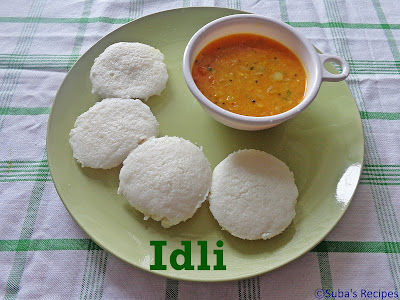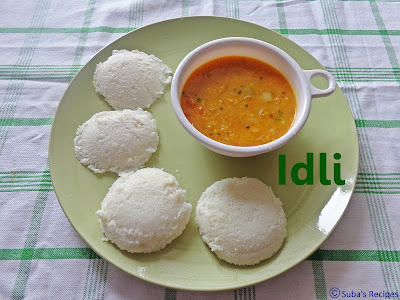This is the most basic batter recipe which is common in every south indian household. It is such a versatile batter recipe which can be used to prepare idli, dosa, uthappam and kuzhi paniyaram. Having a batter like this saves lots of time and effort in preparing breakfast/dinner. Even though it is a basic recipe, I have recorded here with few tips for beginners.
Ingredients
- Idli rice/Parboiled rice - 3 or 4 cups
- Whole Urad dal(without skin) - 1 cup
- Salt - as required
- Water - as required
Method
- Wash and soak urad dal and rice separately for minimum 4 hours to maximum of 6 hours.
- Drain the water from urad dal and grind it first. Do not add all the water at a time. Add water as required, little at a time and mix well every time from the bottom(with your hands after switching off the grinder or using the spatula that comes with the grinder) so that it is evenly ground.
- Urad dal usually takes minimum of 20 to 25 minutes to grind. It should be light and fluffy. Take the urad dal batter in a container.
- Now drain the water from rice and grind it by adding water as required. Add water little by little just like how we do for urad dal. I usually grind to a smooth paste. Rice takes around 15 minutes to grind.
- Mix the ground urad dal and rice with hands after adding required salt. The batter will look like the one in picture 1 below.
- If both dal and rice are ground properly by adding required water, the final batter will be light and fluffy. If it is too thick, idlis also turn out hard.
- To check if the batter has been mixed well, take water in a small bowl and drop little batter in it. If it floats on top(just like in the 2nd picture below), it means the batter has been mixed well. This was a very useful tip from my mother-in-law during my initial days of learning to grind the batter.
- Always store batter only till 1/2 to 3/4th of the container.
- Ferment the batter for 8 hours or overnight, till the batter raises in the container. It ferments well in normal room temperature itself. During cold weather, you can keep it in a warm place - e.g. inside an oven for fermentation.
- A well fermented batter will have foam like texture.
- Use the batter to prepare idli for first 2 days and then can be used for dosa, uthappam and kuzhi paniyaram.
- The batter can be refrigerated and stored for up to a week.
Preparing Idlis
- Mix the batter well before use.
- For idli, consistency of the batter has to be slightly thicker. Hence add water only if required.
- Grease the idli plates with sesame oil or use a clean white cloth to steam the idlis.
- Use an idli cooker or a normal pressure cooker. Add enough water and allow it to boil.
- Meanwhile pour the batter in the plates and when water starts to boil, keep them in the cooker and steam for 7 to 10 minutes. Do not use whistle if using pressure cooker.
- When steaming, arrange the plates in such a way that the holes in the upper plate overlay the idli in the lower plate.
- Also do not place the idli plates in the cooker before the water starts to boil.
- To check if the idli is cooked, check with a fork and if it comes out clean, idlis are cooked.
- Sprinkle little water on the idlis and carefully take them out after few minutes.
- Serve hot with chutney/sambar/milagai podi.
Notes
- Always buy new stock and good quality urad dal for soft idlis. The ratio of rice and dal (4:1 or 3:1) depends on the urad dal quality. If the idlis turn hard and you don't get volume, increase the urad dal quantity.
- Fenugreek seeds can also be soaked and ground along with urad dal. This gives softness to the idli and is also good for health. I generally don't use it but still the idli comes out very soft. If using, add only about 1/2 tsp of fenugreek seeds.
- The time needed for grinding dal and rice depends on the quality of the ingredients. I have given the timings here based on my experience.
- Add salt as per the type and brand of salt you use.
- Always mix the batter well only with your hands. Store the ground batter only till half to 3/4th of the container, as it will raise up after fermentation.




Comments
Post a Comment
Thank you for visiting my blog. Please leave your valuable comments and feedback.